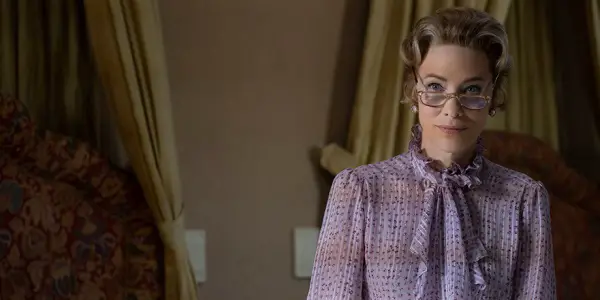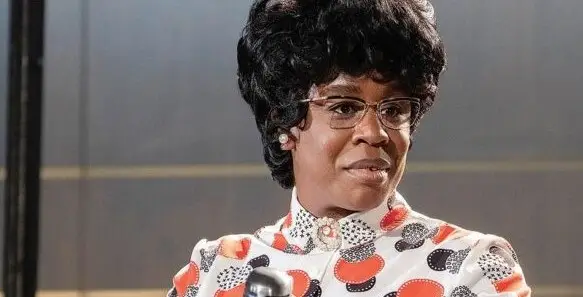MRS. AMERICA: Delivers Phenomenal Performances & Offers A Fresh Look On Equal Rights Amendment Events

Zofia lives in LA and is passionate about pop culture,…
Spoilers for Mrs. America ahead.
Do you remember the 70s in the United States of America? As an immigrant, I only know stories. What about the fight for the Equal Rights Amendment or Phyllis Schlafly? If you’re not sure about the aforementioned woman, you’re not alone. Not many people know the full story of events that transpired in the 70s around the women’s movement and their fight for abortion, gay rights, and more.
Dahvi Waller takes a fresh look at the past of feminists and conservatives in the FX Networks x Hulu limited series, Mrs. America. Alongside many outstanding directors such as Anna Boden, Ryan Fleck, Amma Asante, Laure de Clermont-Tonnerre, and Janicza Bravo, Waller shows the viewers the fierce fight for the ratification of the Equal Rights Amendment. The movement led by Gloria Steinem (Rose Byrne) suddenly has an unexpected opponent. Phyllis Schlafly (Cate Blanchett) comes out of her husband’s shadow to (ironically) oppose the ERA and speak out for all the homemakers and women who want to stay home, and take care for their children. In contrast, the husband is the only one who provides.
Homemakers vs. Feminists
The fight portrayed by Waller hurts. It’s painful to see women fight against each other while they could be doing amazing things when united. But sometimes, the robust value system and diverse point of view make it ultimately impossible. Gloria Steinem and Phyllis Schlafly stand on the opposite sides. The first one wants the ERA to pass. She works tirelessly with many amazing women – a conservative feminist, Jill Ruckelshaus (Elizabeth Banks), Shirley Chisholm (Uzo Aduba), Brenda Feigen-Fasteau (Ari Graynor), Bella Abzug (Margo Martindale), and Betty Friedan (Tracey Ullman). Phyllis, thanks to her friend Alice (Sarah Paulson), stands to fight against them and creates Eagle Forum. The conservative mobilizes a group of like-minded women. Amongst them – Rosemary Thomson (Melanie Lynskey), Pamela (Kayli Carter), and Alice Macray, as mentioned earlier.

Steinem and the group go to every meeting and try to gather the support of as many States as they can. In the meantime, Schlafly writes manifests and speaks up about the danger of the ERA and the group of feminists who “want women to be drafted to war.” While the fight between two sides escalates, one character proves that the transition and harmony may happen without anybody getting hurt.
Mrs. America was created uniquely. Although the character portrayed by Cate Blanchett is the central character, each episode tells the story of a different woman. To fully understand the struggle of change, once needs to view each part carefully to comprehend the power and fight those women had. While we learn more about Gloria Steinem, thanks to the phenomenal performance by Rose Byrne, we also experience many inner battles and arguments on the liberal side. One of the pioneers of those banters is Bella Abzug. Once again, it’s a little disheartening to see all those powerful women fight. But, wherever we have the most potent brains, the heated discussion is bound to happen.
Diversity of Women
While watching Mrs. America, you cannot help but notice the outstanding diversity of females. Although the directing duo of Boden and Fleck worked on the series, the show is almost entirely created by women with women in the forefront throughout the whole course of the series. It’s such a pleasure to see the history of one’s country that is still alive to this day.
All actresses deserve the applause, although it is difficult to enumerate them – there were so many! It’s always exceptionally hard to portray someone who lived and breathed. But Blanchett does so, and exceptionally well. The way the actress changes her way of talking and speaking is extraordinary. She studied the character of Phyllis Schlafly for a long time to achieve the highest authenticity. Byrne keeps up with her and showcases the Steinem with her calming voice, but the heart of a tiger.
Aduba, Martindale, Banks, Graynor, and Ullman perfectly portray well-known historical figures. Especially Aduba – her portrayal of Shirley Chisholm takes her acting skills to the next level. It’s very heartening to see such a force that Aduba unquestionably is, portraying such an important historical figure.

From “the other side of the coin,” the viewers can experience the excellence of Paulson, Lynskey, and Carter. Each actress gives everything for their role, and you can observe it in a way that their role grips your heart and holds it until the very end. Another soul-grasping performance is one by Niecy Nash. The actress portrayed a civil rights advocate, Florynce Kennedy.
The next woman who deserves a standing ovation is Bina Daigeler, a costume designer. The outfits may remind you of the Mad Men era, but they’re even better. Each outfit is meticulously prepared and almost the same as the people that the actresses portray.
The Wisdom of the Series
As I wrote in my other article about Mrs. America, the creators’ point is not to villainize one side or another. Instead, the viewers get a chance to see both feminists and conservatives. They also see their sides of the story where every woman holds great values that may not be agreeable for some, but, for them, are sacred. The series may also be highly valuable for younger people who don’t exactly know the history of the Equal Rights Amendment and strong women who fought for it. We don’t talk enough if people like Flo Kennedy or Shirley Chisholm. And we should. It’s also worth knowing more about Phyllis Schlafly. She may not be someone we agree with, but we cannot refuse her force and fierceness. Blanchett showcases the excellent speaking skill that sometimes was her enemy. We can see it in the episode about couples debate in which Brenda Feigen-Fasteau demanded Phyllis to “cite the case” that the latter simply made up for the sake of her argument.

One of the best episodes is the one titled Houston that focuses on Sarah Paulson and her character, Alice Macray. Alice proves that the person can go through transition and change their belief system while not hurting anyone. Although Alice didn’t totally change and was still a homemaker when we leave her, she did understand the “feminist side” better while in Houston. It’s when Alice, high as a kite, gets lost and ends up with feminists, discovering the real face of females from a women’s movement.
Mrs. America is an extraordinary limited series. It’s wicked, empowering, and, at times, frustrating. Just like a life of almost every woman I know. Everybody should take some time and watch its nine episodes. What breaks the heart at the end is that the Equal Rights Amendment didn’t pass, to this day. But it shows us strong women that are role models even now.
What did you think about Mrs. America? Which female character influenced you the most?
Watch Mrs. America
Does content like this matter to you?
Become a Member and support film journalism. Unlock access to all of Film Inquiry`s great articles. Join a community of like-minded readers who are passionate about cinema - get access to our private members Network, give back to independent filmmakers, and more.
Zofia lives in LA and is passionate about pop culture, television. and Stevie Nicks. She graduated from the University of Wroclaw, Poland with a Bachelor’s Degree in Journalism and Social Communication with Creative Writing. Her work revolves around women in television and film. She is a staff writer First Showing and Contributing Writer for AwardsWatch, Film Inquiry, Screen Queens, and In Their Own League. She loves the 'Scream' movies, 'Carol' and 'Big Little Lies'. – @thefilmnerdette












